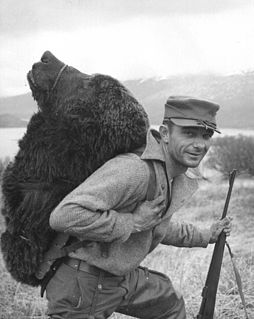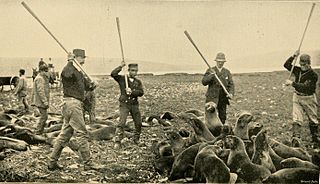 W
WAlligator hunting is the capture and killing of gators. With the appropriate licenses and tags, the American alligator can legally be hunted in the Southeastern United States. The states of Florida, Georgia, Alabama, Arkansas, Mississippi, Louisiana, North Carolina, South Carolina, and Texas all distribute alligator hunting licenses.
 W
WBear hunting is the act of hunting bears. Bears have been hunted since prehistoric times for their meat and fur. In addition to being a source of food, in modern times they have been favoured by big game hunters due to their size and ferocity. Bear hunting has a vast history throughout Europe and North America, and hunting practices have varied based on location and type of bear.
 W
WBoar hunting is generally the practice of hunting wild boars, but can also extend to feral pigs and peccaries. A full-sized boar is a large, powerful animal, often having sharp tusks which it uses to defend itself. Boar hunting has often been a test of bravery.
 W
WJackal coursing involves the pursuit of jackals with dogs.
 W
WLion hunting is the act of hunting lions. Lions have been hunted since antiquity.
 W
WA molecatcher is a person who traps or kills moles in places where they are considered a threat to crops, lawns, or gardens.
 W
WRabbiting is the sport of hunting rabbits. It often involves using ferrets or dogs to track or chase the prey. There are various methods used in capturing the rabbit, including trapping and shooting. Depending on where the hunting occurs, there may be licenses required and other rules in regards to methods being used.
 W
WA rat-catcher is a person who practices rat-catching as a professional form of pest control.
 W
WRhino poaching in Assam is one of the major environmental issues in India which continues in the region of Kaziranga National Park, Manas National Park and some other grasslands of Assam. These rhinos are inhabited most of the floodplain of the Indogangetic and Brahmaputra riverine tracts and the neighboring foothills.
 W
WSeal hunting, or sealing, is the personal or commercial hunting of seals. Seal hunting is currently practiced in ten countries: United States, Canada, Namibia, Denmark, Iceland, Norway, Russia, Finland and Sweden. Most of the world's seal hunting takes place in Canada and Greenland.
 W
WTiger hunting is the capture and killing of tigers. Humans are the tigers' most significant predator, and illegal poaching is a major threat to the tigers. The Bengal tiger is the most common subspecies of tiger, constituting approximately 80% of the entire tiger population, and is found in Bangladesh, Bhutan, Myanmar, Nepal, and India. It has been hunted in these countries for centuries. The tiger has historically been a popular big game animal and has been hunted for prestige as well as for taking trophies. Extensive poaching has continued even after such hunting became illegal and legal protection was provided to the tiger. Now a conservation-reliant endangered species, the majority of the world's tigers live in captivity. Tigers were once considered to be harder to hunt than lions, due to their habit of living alone in dense cover and not noisily asserting their presence with roars as often.
 W
WTurtling is the hunting of turtles. Turtling has been a part of human culture since as far back as the middle of the first millennium BC, where sea turtles such as the hawksbill sea turtle were eaten as delicacies in countries such as China. While consumption and hunting of turtles is less common than it was in the past, this practice is still a part of communities throughout the globe, whether done legally or illegally.